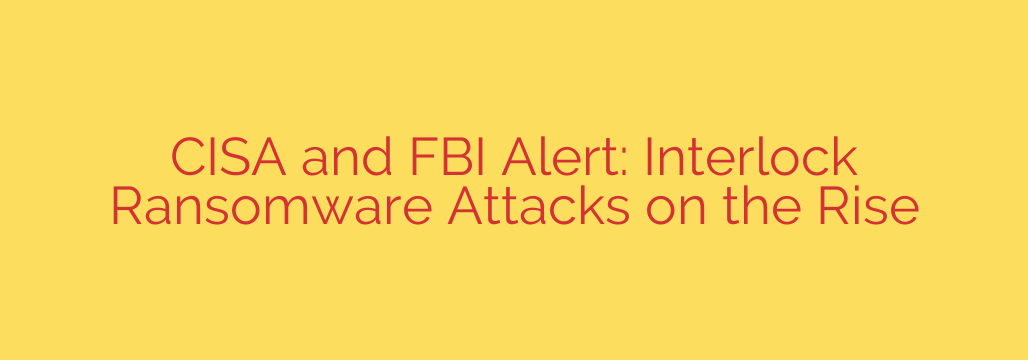
Protecting Your Organization from the Growing Interlock Ransomware Threat
A new and dangerous strain of ransomware, known as Interlock, is actively targeting organizations, presenting a significant cybersecurity threat to critical sectors. This ransomware employs a sophisticated “double extortion” tactic, meaning attackers not only encrypt your vital data but also steal it first, threatening to leak the sensitive information publicly if their demands are not met.
This approach puts immense pressure on victims, as it combines the operational disruption of a traditional ransomware attack with the severe reputational and legal damage of a data breach. Understanding how Interlock operates and taking proactive defensive measures is crucial for safeguarding your organization.
What is Interlock Ransomware?
Interlock is a ransomware variant that uses a powerful combination of AES and RSA encryption algorithms to lock files, making them completely inaccessible. Once a system is compromised, the ransomware systematically encrypts files and renames them with the .interlock extension.
A ransom note, typically a text file named README.txt, is then left on the compromised systems. This note contains instructions for the victim, detailing the attackers’ demands and how to make a payment to supposedly receive a decryption key and prevent the public release of stolen data.
The most critical aspect of this threat is its double-extortion model. Before launching the encryption process, the attackers exfiltrate large volumes of sensitive files from your network. This stolen data becomes their primary leverage, as they threaten to publish it on the dark web if the ransom is not paid.
Who Are the Primary Targets?
While any organization can be a target, cybercriminals deploying Interlock have shown a focus on sectors where downtime and data leaks cause maximum damage. These include:
- Critical Infrastructure, including manufacturing and energy sectors
- Healthcare and Public Health organizations
- State and Local Government agencies
These sectors are often targeted because they manage sensitive public data, are considered essential services, and may have limited cybersecurity resources, making them prime candidates for extortion.
How Interlock Attackers Gain Access
Understanding the attackers’ entry points is the first step toward building a strong defense. Interlock operators typically infiltrate networks using a few common methods:
- Phishing Campaigns: Crafty emails designed to trick employees into clicking malicious links or downloading compromised attachments.
- Exploitation of Unpatched Vulnerabilities: Taking advantage of known security flaws in software, firewalls, or virtual private networks (VPNs) that have not been updated.
- Compromised Credentials: Using stolen or weak usernames and passwords to gain direct access to networks, often through exposed services like Remote Desktop Protocol (RDP).
Actionable Security Measures to Prevent an Interlock Attack
Proactive defense is the most effective strategy against ransomware. Implementing a multi-layered security approach can significantly reduce your risk of a successful attack.
Implement Robust Backup and Recovery Plans: Regularly back up all critical data. Crucially, ensure your backups are stored offline and are immutable (cannot be altered or deleted by attackers). Test your recovery procedures frequently to ensure you can restore operations quickly after an incident.
Enforce Multi-Factor Authentication (MFA): Require MFA for all remote access points, privileged accounts, and critical applications. This single step can block the vast majority of attacks that rely on compromised credentials.
Prioritize Patch Management: Keep all operating systems, software, and firmware updated. Develop a rigorous process for patching known exploited vulnerabilities as soon as updates become available.
Educate Your Workforce: Conduct ongoing security awareness training for all employees. Teach them how to recognize and report phishing attempts, use strong passwords, and understand their role in protecting the organization’s data.
Secure Your Network: Segment your network to prevent attackers from moving laterally from one system to another. Disable unused ports and services, especially public-facing ones like RDP, if they are not essential for business operations.
Develop an Incident Response Plan: Don’t wait for an attack to figure out what to do. Create a detailed incident response plan that outlines roles, responsibilities, and communication strategies. Practice this plan with tabletop exercises to ensure everyone is prepared.
What to Do If You Are Attacked
If you suspect you have been hit by Interlock ransomware, it is vital to act quickly and methodically.
- Isolate the infected systems immediately from the rest of the network to prevent the ransomware from spreading further.
- Preserve evidence by taking forensic images of affected systems before you begin recovery. This data is critical for investigation.
- Report the incident to the appropriate cybersecurity authorities and law enforcement agencies. They can provide assistance and use the information to track the attackers.
- Do not pay the ransom. Official guidance strongly advises against paying. There is no guarantee you will get your data back, and payments fund the criminal enterprise, encouraging future attacks against other victims.
By taking these threats seriously and implementing layered, proactive security controls, your organization can build resilience and significantly reduce the risk of falling victim to Interlock and other devastating ransomware attacks.
Source: https://www.bleepingcomputer.com/news/security/cisa-and-fbi-warn-of-escalating-interlock-ransomware-attacks/








